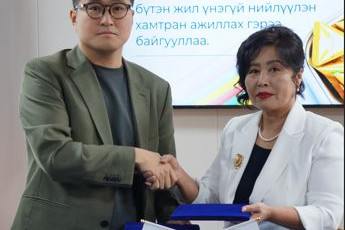
Гурван этгээдийн хэлэлцээр Монгол Оросын хил дагуу орших Хиагт хот буюу 18-р зууны эхнээс Орос, Монгол, Хятадын худалдаа арилжааны үндсэн цэг төвлөрсөн хотод болсон. Орос Хятадын худалдааны ихэнх хувь Хиагтаар дайрч өнгөрдөг байсан.
Хятад улс уг хэлэлцээрт орсон гол нөхцөл нь:
1. Монгол улсын олноо өргөгдсөн оны цолыг хүчингүй болгох
2. Тусгаар тогтнолыг нь хүчингүй болгох
3. Хааны цолыг хэрэгсэхгүй болгохыг Монгол улсаар хүлээн зөвшөөрүүлэх явдал байсан.
Гурван улсын хэлэлцээр Монгол улсын худалдаа хил гаалийн тухай харилцан тохиролцсон юм. Мөн Орос, Хятад иргэдийн эрхийг Оросын Консул болон түүний томилсон хүмүүс Хятадын сайд ба түүний түшмэлүүд хамгаалж хариуцахаар болсон.

Хиагтын гэрээнд оролцсон Монгол улсын засгийн газар түүний бүрэн эрхт төлөөлөгчдийн тавьсан гол зорилго нь:
1. 1911 онд тунхагласан улсынхаа тусгаар тогтнолоо баталгаажуулах
2. Монгол Улсын засгийн газрыг дэмжиж нэгдэхээ илэрхийлсэн Өвөр Монгол болон бусад Монгол үндэстнээ өөрсдөдөө хамааруулах зорилго байсан.
Энэ зорилго хэрэгжсэн байдал нь:
1. Монгол Улс эзэн хаантай
2. Үндэсний засгийн газартай
3. Өөрийн асуудлаа дотооддоо шийдэх эрхтэй
4. Өөрийн цэрэгтэй
5. Нутаг дэвсгэртэй
6. Тусгайлан тогтоосон хил хязгаартай
7. Хятад иргэдийг олноор оруулахгүй байх
8. Бусад улсын цэргийг нутаг дэвсгэртээ байрлуулахгүй байх
9. Худалдааны талаар Олон Улсын Гэрээ байгуулах эрхтэй болсон
10. Дээрх эрхийг хэрэгжүүлэхэд Хаант Орос улс болон Хятад улс оролцохгүй байхаар тохиролцсон
11. Уг гэрээгээр Монголын улс төр хязгаарлагдмал шинжтэй болсон ч гэрээний эхэд "Улс" гэдэг үгийг оруулахаар болсон.
Гурван улсын гэрээнд Хятадын засгийн газар түүний бүрэн эрхийн төлөөлөгчдийн тавьсан зорилго нь:
1. Ар, Өвөр Монголыг өөртөө бүрэн хамааруулж Манж Чин улсыг залгамжлагч гэж өөрийгөө үзэж Монгол үндэстний талаарх бүх эрхийг өвлөн авч хадгалдаг.
2. Үүний тулд Орос Хятадын тунхагыг Монгол улсаар хүлээн зөвшөөрүүлэх, МУ-ын тусгаар тогтнол оны цол хааны цолыг хэрэгсэхгүй болгох зорилго тавьсан.
Хятадын тавьсан зорилго хэрэгжсэн байдал нь:
1. Өвөр Монголыг өөртөө авч чадсан
2. Ар Монголын хувьд Орос болон Монголын хүчтэй эсэргүүцэл дээр тулгарч нэр төдий сюзернитет эрхтэй үлдсэн
3. Хэлэлцээрийн явцад Хятадын төлөөлөгчид Монголыг "Улс" гэж томьёолохыг эсэргүүцэж хэрэв ингэж бичвэл Хятад улсаас салсан болон хэмээн Монголыг тусгаар тогтнолоо устгаж Хятадын бүрэлдэхүүнд орохыг шаардсан ч бүтээгүй.
Гурван улсын гэрээнд оролцсон Оросын засгийн газар болон түүний бүрэн эрхт төлөөлөгчдийн тавьсан гол зорилго нь:
1. 1911 оны Монголын үндэсний хувьсгалд тусалснаараа олж авсан улс төр, эдийн засгийн байр сууриа баталгаажуулах.
2. Ар Монголыг өөрийн нөлөөний эрхшээлд голлосон улс болгохыг зорьсон.
Оросын талын тавьсан зорилго хэрэгжсэн байдал нь:

1. Хиагтын хэлэлцээрийн эхний үеэр Хаант Орос улс Монгол улстай мөнгө зээлдүүлэх, буу зэвсгийн, төмөр зам байгуулах, цахилгаан мэдээний тухай 4 зүйлийн гэрээ байгуулсан нь Монголд олж авсан улс төр, эдийн засгийн байр сууриа бататгасан явдал байсан.
2. Ар Монголд Хятадын Сюзернитет эрхийг ёс төдий тогтоож өөрийн холбоотон болох Англи, Франц улсуудын хилийн талаар байр суурьтай сөргөлдөхгүй байхыг хичээж байсан.
Хиагтын гэрээнд автономи буюу өөртөө эзэрхсэн хэмээх нэр томьёог хэрэглэсэн нь тухай үеийн ОУХ-нд бие даасан улсын утгаар хэрэглэж ирсэн жишиг. Гэрээний явцад болон түүний дараа ямар нэгэн маргаан гарвал тухайн үеийн дэлхийн нийтийн хэл болсон Франц хэлийг гэрээний үндсэн хэл болгохоор тохиролцсон юм. Учир нь: Аль нэг тал нь өөрийн хэлээр өөрийн улсын эрх ашгийг урьтал болгон хэлэлцээрийн агуулгыг гуйвуулахаас сэргийлж чадсан юм. Хиагтын хэлэлцээрт Монголын нутаг дэвсгэрийг зааглан тогтоосон нь Хятадаас тусгай, ОУЭЗ-н субъект мөнийг зөвшөөрсний нотолгоо болсон. Ийнхүү 1915 оны 6-р сарын 7-ны өдөр Хиагтын гэрээ түүний үйл явц өндөрлөсөн.

Ш.Үнэнтөгс
Treaty of Kyakhta 1915- A Treaty between Russia and China
Along with the Treaty of Nerchinsk (1689), this regulated the relations between Imperial Russia and the Qing Empire of China until the mid nineteenth century. It was signed at the border city of Kyakhta, August 23, 1727.
Results
Diplomatic and trade relations were established that lasted until the mid nineteenth century.
It established the northern border of Mongolia (what was then the Russo-Chinese border).
The caravan trade from Kyakhta opened up (Russian furs for Chinese tea).
Agreement with Russia helped China expand westward and annex Xinjiang.
Background
By the 1640s Russian adventurers had taken control of the forested area north of Mongolia and Manchuria. From 1644 the Manchus made themselves masters of China (Qing Dynasty). In 1689 the Treaty of Nerchinsk established the northern border of Manchuria north of the present line. The Russians retained Trans-Baikalia between Lake Baikal and the Argun River north of Mongolia.
At the time of Nerchinsk what is now Mongolia had just been captured by the Oirat Zunghar Khanate. These people were gradually pushed back westward. This raised the question of the Russo-Manchu border in Mongolia and opened the possibility of trade from the Lake Baikal area to Peking. The Manchus wanted an agreement because they were worried about possible Russian support for the Oirats and did not want disobedient subjects fleeing to the Russians. Many of the Cossacks in Siberia were rather close to bandits and could cause trouble if not restrained by the Tsar. The Russians had neither a reason nor the means to push south and were more interested in profitable trade. The Russians had no hope of sending a serious army this far east and the Manchus had no interest in the frozen forests of Siberia.
Negotiations
From the 1710s the Kangxi Emperor began to put pressure on Saint Petersburg for an agreement, largely by interfering with the caravan trade. The Lev Izmailov mission in 1719/22 to Peking produced no results.
Just before his death, Peter the Great decided to deal with the border problem. On October 23, 1725 Sava Vladislavich, a Serb in the Russian service, left Saint Petersburg with 1,500 soldiers and 120 staff including map-makers and priests. Before reaching Peking in November 1726, he picked up Lorents Lange and Ivan Bucholz and sent out cartographers to survey the border. The negotiators on the Manchu side were Tulishen and Dominique Parrenin (??this sounds like a Russian misspelling of a French name). After six months a draft treaty was worked up, but it became clear that neither side had adequate maps. In May Vladslavich and Tulishen went back to Selenginsk near Lake Baikal to get the waiting maps.
By August 31 a draft treaty was drawn up ('Treaty of Bura' after a nearby river). Work quickly began setting up border markers starting from Kyakhta on the Selenga River. The 'Abagaitu Letter' listed 63 markers from Kyakhta east to the Argun River. The 'Selenginsk Letter' listed 24 markers west from Kyakhta to the "Shabindobaga River on the northwest slopes of the Altay Mountains" (??this needs to be located). The 'Treaty of Bura' was sent to Peking to be combined with work already done there. The result was sent back to the frontier and the Treaty of Kyakhta was signed on 25 June, 1728 (old style). The treaty had three official versions, in Russian, in Latin and in Manchu. No official Chinese version of the treaty exists.
Articles
The Treaty had eleven articles, the core of which dealt with commercial relations and diplomatic immunities.
Articles I and XI spoke of eternal peace and cooperation between the two nations, and concerned itself with the language and organization of the rest of the document.
Article II dealt with the exchange of fugitives.
Article III, along with VII, delineated the new borders, leaving only territory along the Irtysh River unassigned. The fate of this land, according to the treaty, would be determined in the future by ambassadors or further correspondence between the two nations' capitals.
Article VI dealt with commercial relations; from this treaty and others, Russia gained far more favorable commercial arrangements with the Chinese than most European countries, who traveled by sea and traded at Canton.
Article V allowed for the establishment of a Russian religious institution in Beijing.
Article VI, along with IX, concerned itself with the forms and modes of diplomatic intercourse between the two nations, both of which had complex systems of bureaucracy and protocol.
Article VIII, along with X, discussed the methods and procedures for settling future disputes.
1768: On 18 October 1768 a Convention was signed modifying Article X of the original treaty making punishments more explicit. This was due to the Qing conquest of the Zunghar Khanate, causing rebels to cross the border and other problems which led the Chinese to curtain trade in 1762 and suspend it in 1765.
1915 On 25 May 1915, China, Russia and Outer Mongolia made a second treaty of Kyakhta. Basically: Russia and China recognize Outer Mongolia's autonomy, but Mongolia recognizes China's sovereignty and will make no treaties with foreign countries. This had the effect of reducing Outer Mongolia's autonomy within the new Republic of China, but it became moot after the October Revolution when Mongolia lost its protector.
Эх сурвалж: SONIN.MN

































